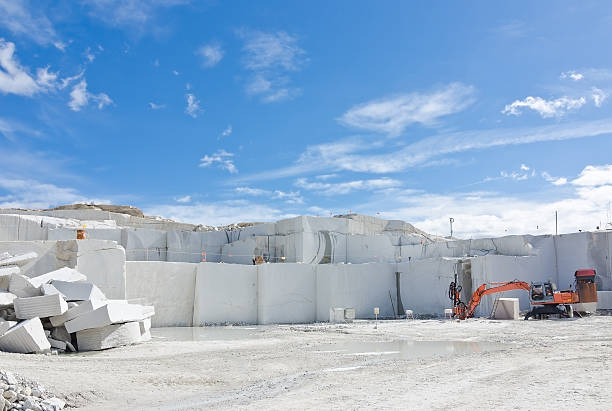The Hidden Treasures: Exploring Granite Quarries in South Africa
The Hidden Treasures: Exploring Granite Quarries in South Africa
Blog Article
Uncovering the Rich History and Sustainable Practices of Granite Quarrying
As we base on the precipice of revealing the intricate tapestry of granite quarrying, a journey with time discloses not just the physical act of extracting stone yet likewise the social and historical value woven into the extremely textile of this practice. From the old beginnings that laid the foundation for contemporary quarrying techniques to the lasting methods that are forming the future of this industry, each sculpt mark on granite surface areas informs a story waiting to be discovered (granite quarries in south africa). The heritage of granite quarrying extends far beyond plain removal; it is a testament to human ingenuity, durability, and the long-lasting attraction of this impressive stone
Ancient Origins of Granite Quarrying
Dating back to ancient human beings, the technique of quarrying granite has been an important component of human background and architectural development. The earliest evidence of granite quarrying go back to old Egypt, where massive pyramids and complex sculptures were crafted from this sturdy stone. The Egyptians utilized primitive tools to draw out granite blocks from quarries, showcasing the value of this product in their monumental constructions.
Moving ahead in background, the Greeks likewise made substantial contributions to the quarrying of granite. The Greeks utilized granite in different building wonders, such as holy places and sculptures, showing their ability in shaping and sculpting this durable stone. The Romans further fine-tuned the methods of quarrying granite, utilizing sophisticated tools like blades and hammers to extract and shape granite for their iconic frameworks.
Via the centuries, the technique of quarrying granite has actually progressed, with contemporary technologies enhancing efficiency while keeping the classic charm of this natural stone - granite quarries in south africa. From old human beings to modern building contractors, the tradition of granite quarrying continues to form our globe
Development of Quarrying Techniques
The evolution of quarrying strategies has been marked by a continual development towards better effectiveness and precision in extracting granite. From the rudimentary approaches utilized by our ancestors to the innovative innovations utilized in modern-day quarrying operations, the industry has actually gone through considerable developments. Early quarrying strategies included manual work with basic devices such as blades, hammers, and wedges to remove granite blocks from the earth. As civilizations advanced, techniques like fire-setting and primitive nitroglycerins were introduced to promote the extraction procedure.
Innovations in computer-controlled equipment and 3D modeling have optimized quarrying operations, leading to minimal environmental impact and improved sustainability practices. As the demand for granite continues to rise, the evolution of quarrying techniques remains integral to meeting sector requires successfully and sustainably.
Social Significance of Granite
Granite holds a profound cultural importance throughout different people because of its long-lasting presence in architectural masterpieces and revered monuments. From the stunning pyramids of Egypt to the complex makings of the Angkor Wat holy place in Cambodia, granite has actually been a product of other option for revealing majesty and long life in social heritage. In old Rome, granite columns embellished holy places and public buildings, representing toughness and permanence. The cultural value of granite expands beyond its physical characteristics; it embodies durability, security, and Continued timelessness, making it an icon of sustaining legacies and customs.

Sustainable Practices in Quarrying
Amidst the abundant history of granite quarrying and its cultural value exists a growing focus on sustainable practices within the sector. As environmental recognition and issues about source exhaustion have heightened globally, the quarrying field has increasingly welcomed lasting approaches to reduce its influence on the atmosphere and surrounding neighborhoods.

Additionally, improvement and rehab of quarry sites post-extraction are essential to sustainable practices. By recovering quarried locations to an all-natural or beneficial state, such as creating wild animals environments or entertainment areas, quarriers can balance out the environmental footprint of their operations and contribute favorably to the neighborhood ecosystem.
Legacy of Granite Quarrying
With a historical background soaked in craftsmanship and industrial progression, what withstanding effect has granite quarrying left on the landscape of contemporary society? The heritage of granite quarrying goes beyond simple extraction methods; it has shaped building marvels, urban landscapes, and social heritage worldwide. The sturdy nature of granite has actually made it a recommended option for monuments, review structures, and framework, standing as a testament to the skill and creativity of quarry workers across generations.
In addition, the financial footprint of granite quarrying can not be forgotten. The market remains to give job opportunity and drive neighborhood economies in regions where granite removal is widespread. It has also spurred technical developments in quarrying strategies and tools, bring about a lot more reliable and sustainable practices.
In terms of sustainability, the legacy of granite quarrying includes efforts to alleviate environmental effects via reclamation projects and liable source management. By stabilizing financial interests with environmental stewardship, the industry strives to make sure that future generations can proceed to take advantage of this enduring natural deposit.
Final Thought

Report this page